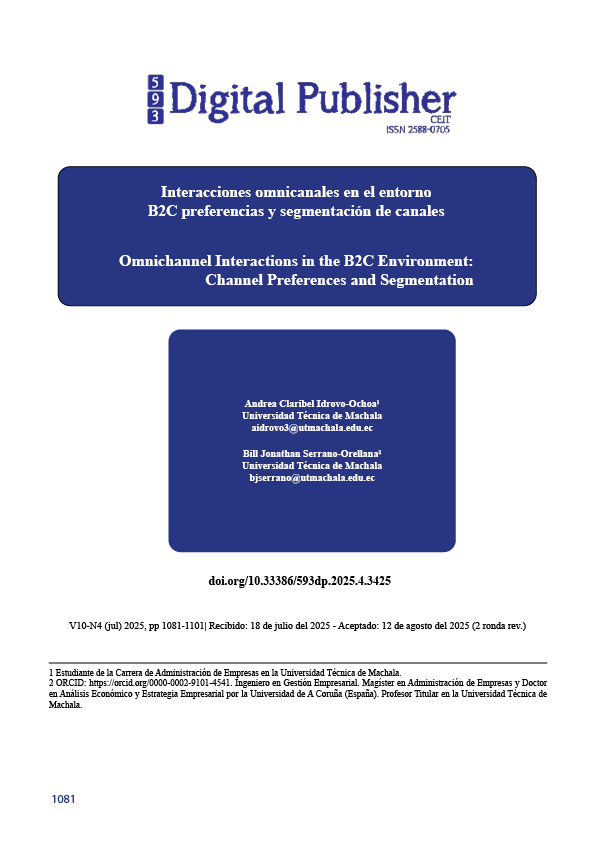Omnichannel Interactions in the B2C Environment: Channel Preferences and Segmentation
Main Article Content
Abstract
This study aims to analyze omnichannel interaction in commercial microenterprises in the city of Machala, Ecuador, by collecting primary and secondary data to determine the digitalization environment and transformation of consumer habits. A mixed methodological approach was used, with a non-experimental-cross-sectional design and descriptive scope, employing a questionnaire to 150 microenterprises selected through a non-probabilistic convenience sampling. The questionnaire was analyzed using techniques such as principal component analysis (PCA) and K-means. The results show a fragmented and uneven inclusion regarding digital application, allowing the identification of five main factors: digital interaction, consumer personalization and analysis, technological investment, customer experience, leadership, and change management. K-means analysis clarifies two profiles: digitally mature microenterprises characterized by a strategic focus, sustained investments in technological infrastructure, and customer orientation; and another lagging group, with minimal technological investment and limited internal training. The conclusion is that organizational leadership, investment capacity, and customer focus are key factors in consolidating an effective digital culture. Furthermore, the need to implement differentiated policies that promote closing digital divides, fostering innovative leadership, and strengthening strategic capabilities, while considering the structural limitations of local microenterprises, is highlighted.
Downloads
Article Details

This work is licensed under a Creative Commons Attribution-NonCommercial-ShareAlike 4.0 International License.
1. Derechos de autor
Las obras que se publican en 593 Digital Publisher CEIT están sujetas a los siguientes términos:
1.1. 593 Digital Publisher CEIT, conserva los derechos patrimoniales (copyright) de las obras publicadas, favorece y permite la reutilización de las mismas bajo la licencia Licencia Creative Commons 4.0 de Reconocimiento-NoComercial-CompartirIgual 4.0, por lo cual se pueden copiar, usar, difundir, transmitir y exponer públicamente, siempre que:
1.1.a. Se cite la autoría y fuente original de su publicación (revista, editorial, URL).
1.1.b. No se usen para fines comerciales u onerosos.
1.1.c. Se mencione la existencia y especificaciones de esta licencia de uso.
References
Alvarado, Á., & Vergara, N. (2018). El desafío del comercio electrónico en la economía del Ecuador. Polo del Conocimiento, 3(1), 67-86. https://doi.org/10.23857/pc.v3i1Mon.681
Arora, S., & Sahney, S. (2017). Webrooming behaviour: A conceptual framework. International Journal of Retail & Distribution Management, 45(7/8), 762-781. https://doi.org/10.1108/IJRDM-09-2016-0158
Ben, M., Miltgen, C., & Slama, B. (2022). Is the shopper always the king/queen? Study of omnichannel retail technology use and shopping orientations. Journal of Retailing and Consumer Services, 65, 102844. https://doi.org/10.1016/j.jretconser.2021.102844
Butkouskaya, V., Oyner, O., & Kazakov, S. (2023). The impact of omnichannel integrated marketing communications (IMC) on product and retail service satisfaction. Journal of Economics, Finance and Administrative Science, 28(56), 319-334. https://doi.org/10.1108/JEFAS-09-2022-0237
Cajamarca, E., Delgado, J., & Zamora, M. (2023). El impacto del E-commerce como estrategia de comercialización para las microempresas de la ciudad de Machala. Revista Metropolitana de Ciencias Aplicadas, 6(S1), 158-167. https://www.redalyc.org/pdf/7217/721778121018.pdf
Calle, S., Díaz, J., & Iozzeli, M. (2023). PYMES ecuatorianas: comercio exterior y fortalecimiento de mercados internacionales. 593 Digital Publisher CEIT, 9(1), 112-127. https://doi.org/10.33386/593dp.2024.1.2124
Camacho, A. (2022). La omnicanalidad y su importancia estratégica en la mercadotecnia educativa en postpandemia. d´perspectivas siglo XXI, 9(18), 26-40. https://doi.org/10.53436/P4D1A3M7
Cicea, C., Marinescu, C., & Silviu, C. (2023). Multi-Channel and Omni-Channel Retailing in the Scientific Literature: A Text Mining Approach. Journal of Theoretical and Applied Electronic Commerce Research, 18, 19-36. https://doi.org/10.3390/jtaer18010002
Cui, X., Xie, Q., Zhu, J., Akhter, M., Shakir, M., & Shakaib, M. (2022). Understanding the omnichannel customer journey: The effect of online and offline channel interactivity on consumer value co-creation behavior. Journal of Retailing and Consumer Services, 65, 102869. https://doi.org/10.1016/j.jretconser.2021.102869
Faria, S., & Carvalho, J. (2025). From a multichannel to an optichannel strategy in retail. Journal of Theoretical and Applied Electronic Commerce Research, 20(45), 1-22. https://doi.org/10.3390/jtaer20010045
Flavián, C., Gurrea, R., & Orús, C. (2020). Combining channels to make smart purchases: The role of webrooming and showrooming. Journal of Retailing and Consumer Services, 52, 101923. https://doi.org/10.1016/j.jretconser.2019.101923
Frasquet, M., Ieva, M., & Mollá, A. (2024). Customer inspiration in retailing: The role of perceived novelty and customer loyalty across offline and online channels. Journal of Retailing and Consumer Services, 76, 103592. https://doi.org/10.1016/j.jretconser.2023.103592
Gao, W., & Fan, H. (2021). Omni-channel customer experience (in)consistency and service success: A study based on polynomial regression analysis. Journal of Theoretical and Applied Electronic Commerce Research, 16, 1997-2013. https://doi.org/10.3390/jtaer16060112
Gerea, C., Gonzalez, F., & Herskovic, V. (2021). Omnichannel customer experience and management: An integrative review and research agenda. Sustainability, 13(5), 2824. https://doi.org/10.3390/su13052824
Gerea, C., & Herskovic, V. (2022). Transitioning from multichannel to omnichannel customer experience in service-based companies: Challenges and coping strategies. Journal of Theoretical and Applied Electronic Commerce Research, 17, 394-413. https://doi.org/10.3390/jtaer17020021
Iglesias, S., & Acquila, E. (2023). The future of e-commerce: Overview and prospects of multichannel and omnichannel retail. Journal of Theoretical and Applied Electronic Commerce Research, 18, 656-667. https://doi.org/10.3390/jtaer18010033
Insaurralde, N. (2023). La gestión en relación al cliente (CRM), como estrategia de negocio en la ciudad de Pilas, Paraguay. Ciencia Latina Revista Científica Multidisciplinar, 7(3), 5855-5872. https://doi.org/10.37811/cl_rcm.v7i3.6590
León, O., Rios, K., Rojas, V., & Ruiz, G. (2025). Impacto del comercio electrónico en la competitividad de las PYMES: Factores clave y barreras tecnológicas. Revista InveCom, 5(4), 1-8. https://zenodo.org/records/14816581
León, O., Rojas, V., Ríos, K., & Ruiz, G. (2025). Impacto del comercio electrónico en la competitividad de las PYMES: Factores clave y barreras tecnológicas. Revista INVECOM, 5(4), 1-8. https://doi.org/10.5281/zenodo.14816581
Liang, X., Jun, Y., & Wang, N. (2018). Channel integration quality, perceived fluency and omnichannel service usage: The moderating roles of internal and external usage experience. Decision Support Systems, 109, 61-73. https://doi.org/10.1016/j.dss.2018.01.006
Lin, X., Wang, X., & Hajli, N. (2019). Building e-commerce satisfaction and boosting sales: The role of social commerce trust and its antecedents. International Journal of Electronic Commerce, 23(3), 328-363. https://doi.org/10.1080/10864415.2019.1619907
Llamas, R., & Belk, R. (Eds.). (2022). The Routledge handbook of digital consumption. Routledge.
López, A., & López, M. (2019). Estudio omnicanal de las empresas minoristas del sector cosmético en España. REDMARKA. Revista de Marketing Aplicado, 23(2), 19-41. https://doi.org/10.17979/redma.2019.23.2.5660
Matute, V., Viñansaca, X., & Capa, M. (2023). El e-commerce B2C como estrategia de internacionalización de las pymes enfocadas en el sector textil. 593 Digital Publisher CEIT, 8(3), 428-439. https://doi.org/10.33386/593dp.2023.3.1719
Mishra, R., Singh, R., & Koles, B. (2020). Consumer decision-making in omnichannel retailing: Literature review and future research agenda. International Journal of Consumer Studies, 45(2), 147-174. https://doi.org/10.1111/ijcs.12617
Mosquera, A., Ayensa, E., Olarte, C., & Sierra, Y. (2019). Omnichannel shopper segmentation in the fashion industry. Journal of Promotion Management, 25(5), 681-699. https://doi.org/10.1080/10496491.2019.1585599
Mosquera, A., Olarte, C., Juaneda, E., & Sierra, Y. (2018). The role of technology in an omnichannel physical store: Assessing the moderating effect of gender. Spanish Journal of Marketing - ESIC, 22(1), 63-82. https://doi.org/10.1108/SJME-03-2018-008
Muñoz, E., Jacome, E., & Medina, G. (2024). Análisis de la brecha digital y el acceso a recursos tecnológicos en las instituciones de educación secundaria en Ecuador. Ciencia Latina Revista Científica Multidisciplinar, 8(2), 6698-6719. https://doi.org/10.37811/cl_rcm.v8i2.11086
Nieto, L., & Parra, D. (2023). Omnicanalidad: herramienta clave para la mejora de la atención al cliente y la innovación en el sector salud. Revista Colombiana de Computación, 24(2), 39-51. https://doi.org/10.29375/25392115.4850
Orellana, A., González, M., Maldonado, J., & Guerrero, P. (2023). Un acercamiento teórico a la economía digital como alternativa de recuperación pospandemia en Latinoamérica. Estudios de la Gestión, (14), 75-100. http://scielo.senescyt.gob.ec/pdf/egestion/n14/2661-6513-esge-14-00075.pdf
Otzen, T., & Manterola, C. (2017). Técnicas de muestreo sobre una población a estudio. International Journal of Morphology, 35(1), 227-232. https://scielo.conicyt.cl/pdf/ijmorphol/v35n1/art37.pdf
Pesántez, A., Romero, J., & González, M. (2020). Comercio electrónico B2B como estrategia competitiva en el comercio internacional: Desafíos para Ecuador. INNOVA Research Journal, 5(1), 72-93. https://doi.org/10.33890/innova.v5.n1.2020.1166
Ping, Y., & Li, J. (2022). Seamless experience in the context of omnichannel shopping: Scale development and empirical validation. Journal of Retailing and Consumer Services, 64, 102800. https://doi.org/10.1016/j.jretconser.2021.102800
Plekhanov, D., Franke, H., & Netland, T. (2023). Digital transformation: A review and research agenda. European Management Journal, 41(6), 821-844. https://doi.org/10.1016/j.emj.2022.09.007
Pérez, J. (2020). Factores determinantes en la creación de modelos de comercio electrónico, Business to Consumer (B2C) [Tesis doctoral, Universidad a Distancia de Madrid]. Universidad a Distancia de Madrid.
Quisaguano, L., Esquivel, G., & Quimbita, M. (2021). Adopción de estrategias de marketing digital en las microempresas del cantón Mejía. Revista Académica y Científica VICTEC, 2(2), 1-7. http://portal.amelica.org/ameli/journal/572/5724433001/
Riaz, H., Baig, U., Meidute, I., & Ahmed, H. (2022). Factors effecting omnichannel customer experience: Evidence from fashion retail. Information, 12(12), 1-18. https://doi.org/10.3390/info13010012
Roldán, M., Valencia, M., López, D., Restrepo, J., & Vanegas, J. (2022). Omnicanalidad como estrategia competitiva: Una revisión conceptual y dimensional. Estudios Gerenciales, 38(164), 370-384. https://doi.org/10.18046/j.estger.2022.164.5006
Sarmiento, J., Carvajal, A., & López, B. (2024). Fomentando el desarrollo local con estrategias innovadoras de negocios inclusivos y sostenibles. Mundo Fesc, 14(28), 136-145. https://doi.org/10.61799/2216-0388.1589
Schrotenboer, D., Constantinides, E., Herrando, C., & de Vries, S. (2022). The effects of omni-channel retailing on promotional strategy. Journal of Theoretical and Applied Electronic Commerce Research, 17, 360-374. https://doi.org/10.3390/jtaer17020019
Shirazi, F., Abdalla, N., & Shanmugam, M. (2021). The importance of trust for electronic commerce satisfaction: An entrepreneurial perspective. British Food Journal, 123(2), 789-802. https://doi.org/10.1108/BFJ-07-2020-0626
Skare, M., Gavurova, B., & Rigelsky, M. (2023). Innovation activity and the outcomes of B2C, B2B and B2G e-commerce in EU countries. Journal of Business Research, 163, 113874. https://doi.org/10.1016/j.jbusres.2023.113874
Thaichon, P., Phau, I., & Weaven, S. (2020). Moving from multi-channel to omni-channel retailing: Special issue introduction. Journal of Retailing and Consumer Services, 65, 102311. https://doi.org/10.1016/j.jretconser.2020.102311
Van, A., McClelland, R., & Hoang, N. (2022). Exploring customer experience during channel switching in omnichannel retailing context: A qualitative assessment. Journal of Retailing and Consumer Services, 64, 102803. https://doi.org/10.1016/j.jretconser.2021.102803
Van, A., McClelland, R., & Hoang, N. (2024). Omni-channel customer segmentation: A personalized customer journey perspective. Journal of Consumer Behaviour, 23(6), 3253-3275. https://doi.org/10.1002/cb.2401
Véliz, A. (2023). Hacia el futuro digital: E-commerce y transformación en el contexto ecuatoriano. Ciencia Latina Revista Científica Multidisciplinar, 7(6), 8374-8395. https://doi.org/10.37811/cl_rcm.v7i6.9375
Viejo, N., Herrero, Á., Collado, J., & Sanzo, M. (2022). Ni webroomers, ni showroomers: El retail dice ¡bienvenido omni-shopper! Escuela Superior de Gestión Comercial y Marketing, ESIC. https://dialnet.unirioja.es/servlet/articulo?codigo=8657800
Wolf, L., & Steul, M. (2023). Factors of customers’ channel choice in an omnichannel environment: A systematic literature review. Management Review Quarterly, 73, 1579-1630. https://doi.org/10.1007/s11301-022-00281-w
Yang, S., & Zhang, L. (2025). Optimizing an omnichannel retail strategy considering customer segmentation. Evaluation Review, 0(0). https://doi.org/10.1177/0193841X251328710



